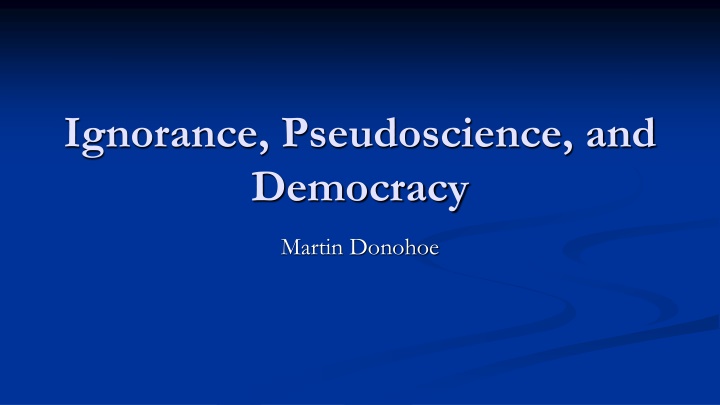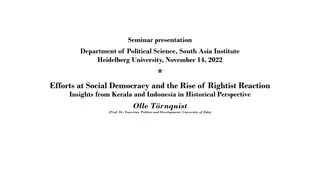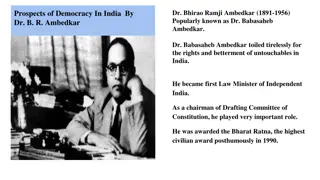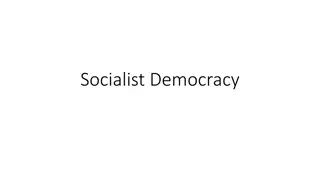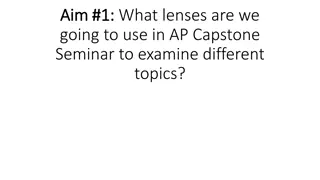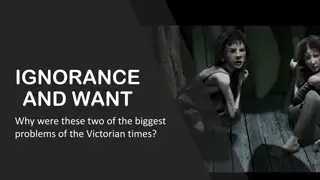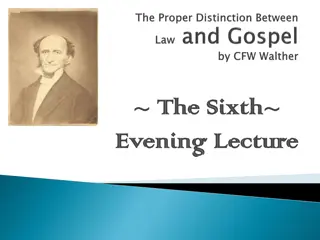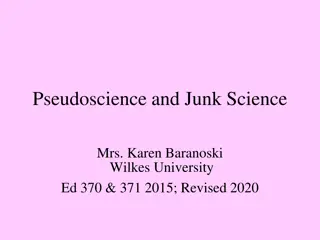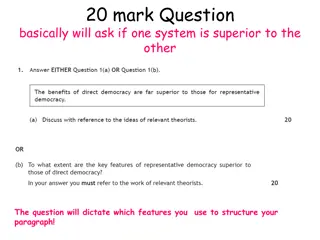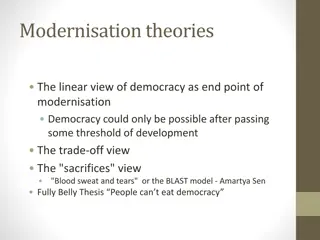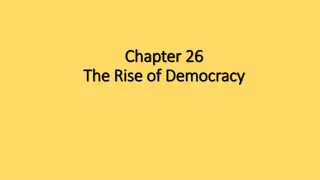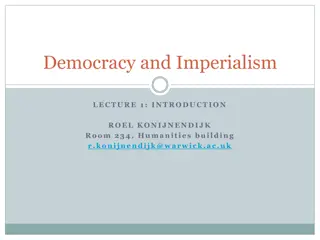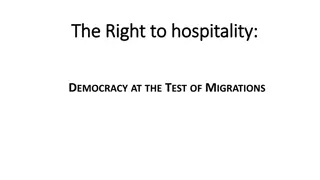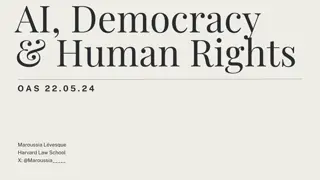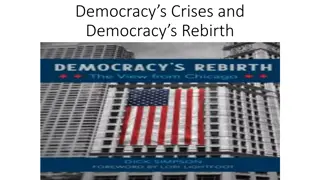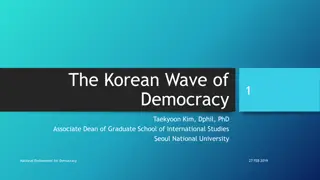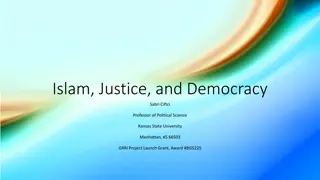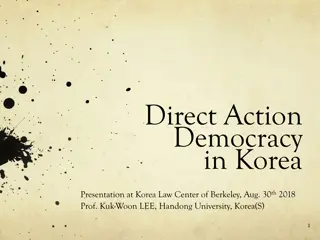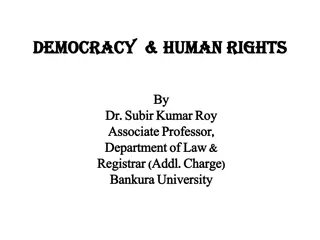Ignorance, Pseudoscience, and Democracy: Challenges and Solutions
In a world where misinformation thrives, the impact on democracy is profound. Carl Sagan's foreboding about the future, the threats of pseudoscience and ignorance to public knowledge and decision-making, and the manipulation of lies in politics are all explored. The essence of informed citizenship, education, and critical thinking is highlighted as crucial safeguards against the erosion of democracy.
Download Presentation

Please find below an Image/Link to download the presentation.
The content on the website is provided AS IS for your information and personal use only. It may not be sold, licensed, or shared on other websites without obtaining consent from the author.If you encounter any issues during the download, it is possible that the publisher has removed the file from their server.
You are allowed to download the files provided on this website for personal or commercial use, subject to the condition that they are used lawfully. All files are the property of their respective owners.
The content on the website is provided AS IS for your information and personal use only. It may not be sold, licensed, or shared on other websites without obtaining consent from the author.
E N D
Presentation Transcript
Ignorance, Pseudoscience, and Democracy Martin Donohoe
Carl Sagan I have a foreboding of an America in my children's or grandchildren's time -- when the United States is a service and information economy; when nearly all the manufacturing industries have slipped away to other countries; when awesome technological powers are in the hands of a very few, and no one representing the public interest can even grasp the issues;
Carl Sagan when the people have lost the ability to set their own agendas or knowledgeably question those in authority; when, clutching our crystals and nervously consulting our horoscopes, our critical faculties in decline, unable to distinguish between what feels good and what's true, we slide, almost without noticing, back into superstition and darkness...
Carl Sagan But if the citizens are educated and form their own opinions, then those in power work for us. In every country, we should be teaching our children the scientific method and the reasons for a Bill of Rights. With it comes a certain decency, humility and community spirit. In the demon-haunted world that we inhabit by virtue of being human, this may be all that stands between us and the enveloping darkness.
Overview Pseudoscience/Ignorance Health, Environment Public Education, Journalism, Advertising, Lobbying, Public Relations, Religion Politics and Elections Threat to Democracy
Thomas Jefferson Information is the currency of democracy
Lies and Manipulation Jonathan Swift: Falsehood flies and the truth comes limping after it Adolf Hitler: If you tell a big enough lie and tell it frequently enough, it will be believed. Those who can make you believe absurdities can make you commit atrocities - Voltaire
Lies and Manipulation Herman Goering: Of course, the people don t want war but the[y] can always be brought to do the bidding of the leaders. That is easy. All you have to do is tell them they are being attacked and denounce the pacifists for lack of patriotism and exposing the country to danger. It works the same way in any country.
Pseudoscience Statements, beliefs, or practices that are claimed to be both scientific and factual but are incompatible with the scientific method
Pseudoscience Examples: Astronomy: astrology, Apollo moon landing hoax Geography: Bermuda Triangle Biology: cryptozoology (Bigfoot, Yeti, etc.) Psychology: conversion therapy, polygraph Paranormal: channeling, dowsing, ESP
Pseudoscience Characterized by contradictory, exaggerated or unfalsifiable claims Rely on confirmation bias rather than rigorous attempts at refutation Lack of openness to evaluation by other experts
Pseudoscience Absence of systematic practices when developing hypotheses Continued adherence long after experimentally discredited. Underlying agenda (e.g., corporate profit, religion)
Characteristics of Pseudoscience Indifferent to facts and valid evidence Looks only for evidence supporting hypothesis Relies heavily on subjective validation Depends on arbitrary conventions of human culture, rather than on unchanging regularities of nature
Characteristics of Pseudoscience Avoids putting its claims to meaningful tests Often contradictory Deliberately creates mystery where none exists, sometimes by omitting important details Does not progress Attempts to persuade with rhetoric, propaganda and misrepresentation
Characteristics of Pseudoscience Appeals to false authority, emotion, sentiment, or distrust of established facts Extraordinary claims and fantastic theories Often described by an invented vocabulary of words with ambiguous meanings Relies on anachronistic thinking Appeals to vanity, fear, magical thinking or desperation
Characteristics of Pseudoscience in Medicine Relies on anecdotes and testimonials Products often claim to be effective against a wide range of unrelated diseases Quick, dramatic results promised for one-time therapies; frequent re-treatments/maintenance treatments required for ongoing therapies Expensive
Characteristics of Pseudoscience in Medicine Disclaimers couched in pseudo-medical jargon Claims that Western Medicine is dangerous Practitioners advise, Don t trust your doctor Claims of no side effects Products claimed to be natural usually are not
Examples of Pseudoscience in Medicine Historical: bloodletting, purging, trephining, mercury for syphilis Contemporary: therapeutic touch, psychosurgery, Reiki, homeopathy, most naturopathic remedies, stem cell and platelet injection clinics (unproven, lucrative, even major academic institutions) Benefits often due to time with patients, active listening, emphasis on mental health, convincing practitioners, suggestible patients
Examples of Pseudoscience in Medicine Direct-to-consumer genetic testing Whole body CT scans Over-testing in concierge/luxury primary care Celebrities: Oprah Winfrey (large audience, promotes fake healers/whole body CT scans, mentored Dr Oz, who promulgates quackery) Gwyneth Paltrow (GOOP)
How Quackery Harms Health dangers: cyanide toxicity from laetrile, electrolyte imbalances from coffee enemas, quadriplegia from cervical spine manipulations Cost Delays in seeking care Perpetuates pseudoscience, undermines scientific medicine
Recognizing Health Scams Claims pitched directly to the media, rather than via publication in peer-reviewed journals Discoverer says that a powerful establishment is trying to suppress his or her work Appeals to false authorities, emotion, or magical thinking Scientific effect involved at the very limits of detection
Recognizing Health Scams Evidence for test or treatment anecdotal / relies on subjective validation Promoter states a belief is credible because it has endured for centuries Need to propose new laws of nature to explain an observation
Vaccination Childhood vaccinations prevented more than 100 million cases of serious disease between 1924 and 2012 Prevent 2-3 million deaths/yr Over 30,000 doses/second worldwide Serious adverse events extremely rare
Vaccination 53% of Americans think vaccines are safe and effective, 16% believe they are unsafe, and 1/3 oppose mandatory childhood vaccination (pre-covid) Discredited research linking vaccines to autism Measles outbreaks among unvaccinated, putting others at risk
Vaccination All states require childhood vaccination for school entry All states have medical exemptions All states except CA, MS, and NY permit religious exemptions MS has lowest rate of vaccine-preventable diseases 17 states permit philosophical exemptions based on personal or moral beliefs
Vaccination Supreme Court has consistently ruled that states are not constitutionally required to permit religious or philosophical exemptions Many state bills proposing elimination of child vaccine requirements for school attendance
Mortality/Incidence of Covid vs Community Vaccine Uptake (pre-delta variant)
Mortality/Incidence of Covid vs Community Vaccine Uptake (including delta variant)
Pseudoscience and Abortion Over of U.S. states have implemented at least 2 abortion restrictions not backed by scientific evidence False links with breast cancer, infertility, and depression Proposed anti-abortion bill in Ohio requiring doctors to re- implant ectopic pregnancies into the uterus Physiologically impossible Doctors not complying would face charges of abortion murder, punishable by life in prison
Pseudoscience and Abortion Crisis pregnancy clinics: peddle misinformation about abortion increasing risk of subsequent infertility and breast cancer, causing fetal pain
Pseudoscience and Abortion Abortion very safe procedure/woman s right Restrictions limit access to abortion, raise costs, and increase unwanted pregnancies Women denied abortion are more likely to: Experience serious complications from the end of pregnancy including eclampsia and death Stay tethered to abusive partners
Pseudoscience and Abortion Women denied abortion are more likely to suffer anxiety and loss of self-esteem in the short term Less likely to have aspirational life plans for the coming year Implications for offspring Dobbs decision
Ignorance of Geography Percent of US teens unable to locate the following on a map: United States 11% Pacific Ocean 29% Japan 58% United Kingdom 68%
Ignorance/Pseudoscientific Beliefs 40% of US citizens do not believe in evolution (2019) and do believe that humans and dinosaurs coexisted (2014) Only 12% of U.S. Protestant pastors believe in evolution 20% of high school biology teachers are creationists
Pseudoscientific Beliefs 40% - 70% believed in global warming in the 2000s, now almost 90% (although only 60% alarmed or concerned) 54% believe places can be haunted (2014) 25% believe in UFOs (2007) 24% believe in reincarnation (2014) 24% believe in astrology (2009)
Pseudoscientific Beliefs 2/3 of Americans believe they have had a paranormal experience 24% believe they can psychically sense others emotional auras 49% believe their homes are haunted (65% of GenZ homeowners) All 2022 data
Ignorance/Pseudoscientific Beliefs 16% believe that people with the evil eye can cast curses or harmful spells 22% of Americans don t know whether an atomic bomb has ever been dropped (2000) 25% of Americans don t know the earth revolves around the sun (2014) Copernicus 16thCentury
Ignorance/Pseudoscientific Beliefs 18% believe in Bigfoot and the Loch Ness Monster (2007) 8% of men / 18% of women believe in astrology and fortune tellers (2007) 14% have consulted a psychic or fortune teller (2009)
Ignorance/Pseudoscientific Beliefs Some states require instructors to teach creation science, intelligent design, and climate change skepticism Americans rank last overall in environmental attitudes and habits (survey of 20 developed countries, 2014) Those who are less green feel less guilt
Environmental Ignorance A majority of Americans believe that electricity in the U.S. is produced in nonpolluting ways Only 25% know that majority (80%) comes from oil, natural gas, coal and wood 33% assume that spent nuclear fuel (from our 104 plants) is stored in a deep underground facility in the West Only 17% are aware that it is mostly stored on-site at powerplants pending a long-term solution
Ignorance/Pseudoscientific Beliefs Use of dietary supplements common (1/3 adults and children took, although just over half were multivitamins and vitamin D; $55 billion spent in 2020; over 100,000 different products available, vs. 1,000+ prescription drugs), despite: Lack of regulation by FDA No to minimal data for many Adverse reactions common 23,000 ER visits and over 2,000 hospitalizations annually
Scientific Ignorance Would you sign a petition to ban dihydrogen monoxide? 1. It can cause excessive sweating and vomiting 2. It is a major component in acid rain 3. It can cause severe burns in its gaseous state 4. It can kill you if accidentally inhaled 5. It contributes to erosion 6. It decreases effectiveness of automobile brakes 7. It has been found in tumors of terminal cancer patients
Many (Most?) Published Research Findings are False (PLOS Med 2005;2(8)e124) Reasons: The smaller the studies conducted in a scientific field, the less likely the research findings are to be true The smaller the effect sizes in a scientific field, the less likely the research findings are to be true The greater the number and the lesser the selection of tested relationships in a scientific field, the less likely the research findings are to be true
Many (Most?) Published Research Findings are False (PLOS Med 2005;2(8)e124) Reasons: The greater the flexibility in designs, definitions, outcomes, and analytical modes in a scientific field, the less likely the research findings are to be true. The greater the financial and other interests and prejudices in a scientific field, the less likely the research findings are to be true The hotter a scientific field (with more scientific teams involved), the less likely the research findings are to be true. However, most medical interventions are helpful, and most scientific investigations lead to significant gains in practical knowledge
Public Education in Disarray U.S. Schools ranked lowest among western nations Inadequate funding, decaying infrastructure Underpaid/undervalued teachers School boards censoring books, distorting history (e.g., slavery) Sex ed topics poorly taught or ignored altogether
Public Education in Disarray Moms for Liberty and other groups hounding parents, teachers, and reasonable school board members MFL head and husband involved in threesome sex scandal, allegations of rape by husband; former Pennsylvania head registered sex offender National HS graduation rate stagnant at 65-70% College tuition costs rising
Television and the Media Smartphones - Average US teen spends 9 hrs/d using social media (8-12 year olds = 6 hrs/d) The average American youth spends 900 hrs/yr in school, 1,500 hrs/yr watching TV By age 65, the average American will have spent 9 yrs watching TV Facebook, Google, YouTube, Pinterest, Twitter, Instagram, Reddit, Match Group, Amazon, others
Journalism Local newspapers closing, consolidation of major media outlets 5 corporations control majority of US media (down from 50 in 1983) Most owned by multinational, multi-billion dollar corporations involved forestry, defense, real estate, fossil fuels, big agriculture, etc. Stories suppressed
Journalism 40% fewer journalists than a decade ago Fake news epidemic; rent-a-crowds; deep fake videos; propaganda (Fox News) Journalists under attack Guardians of the Truth named TIME Magazine s Persons of the Year, 2018 Trump administration ridiculing, threatening journalists
